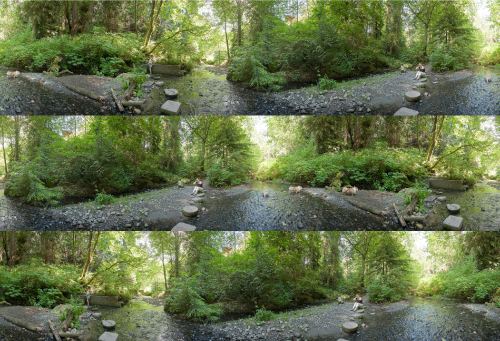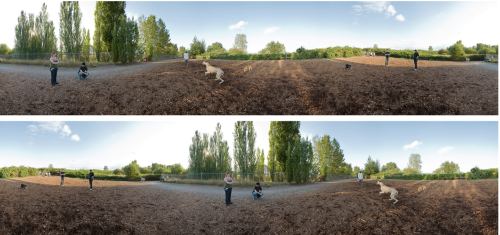How do animals see? Depends on whether they’re predators with eyes front and center, or prey, with eyes on the sides of their heads for an inclusive span.
Paul Berger became interested in the visual world of prey animals after reading Temple Grandin, who redesigns slaughterhouses to take away the terror. According to Grandin, prey animals do not feel anxiety or regret, but they have a fast trigger on fear. When nothing is wrong, they are calm as Buddha, even when seconds from their death.
McDonald’s hired her not because the company is swell in every way but because calm animals die more quickly, more cleanly. Also, with her on the payroll, McDonald’s has something to say in its own defense when criticized by animal rights groups.
Back to Berger and his wide span. (PANORAMAS SERIES, 2008-2010) He offers something rare those whose vision is selective in its focus. In his photos, the world shifts, becomes elastic and enlarged beyond the frame with which we were born, the narrow frame that helps us zero in for the kill.



 Berger:
Berger:
I have been exploring extended synthetic
panoramic imaging, wandering into a kind of “bovine vision” of visual
horizon grazing between 240 and 360 degrees. It is the camera vision of
choice for those who scan the horizon wide, eschewing the specificity
of the pointed gaze for the more generalized awareness of a uniformly
focused peripheral vision.Technically, this series, as has been
the case with most “straight” photography in the past, at first appears
to be a seamless, straightforward transcription of the three
dimensional world. However, they are, in fact, the result of a highly
processed data stream. This stream begins with a sequence of seven to
ten wide-angle (24mm) individual photographs, taken with a digital
camera attached to a tripod on a head that allows for rotation about the
“nodal” point of the lens. The resulting images are merged, in
software, into either a cylindrical or spherical digital space. After
adjustments, a two-dimensional frame is imposed within this space (the
final “photograph”) and the result is exported back into a conventional
digital file.
Responding to my question about his (to me) invisible career, Berger replied with unruffled patience:
I have been published in Light and Lens, Photography in the Digital Age, by Robert Hirsh, 2007; Nash Editions: Photography and the Art of Digital Printing, ed. Garrett White, 2007; Photography, 8th Edition; London & Upton, 2004, Criticizing Photographs, An Introduction to Understanding Images, Terry Barrett, 2002; and Seizing the Light: A History of Photography; Robert Hirsh, 2000.
Also, photographs from the Panorama series will be published in the spring as part of The Digital Eye by Sylvia Wolf. For someone who is well known in Seattle because he is on the art faculty at the University of Washington, his work is rarely discussed. His 2003 retrospective at Chicago’s Museum of Contemporary Photography traveled, but not to Seattle. (Artforum review of that show here.) There is more than one way to have a career.



I would be curious to see a Top Five List of living photographers from both you and Paul.
I’ll email Paul and ask him. You hear nothing, it means he didn’t do it. I’d have a tough time coming up with a top five because there are so many living photographers I love in a variety of contexts. I could come up with a different top five list daily for a month. But whatever list I made, William Eggleston would always be on it.